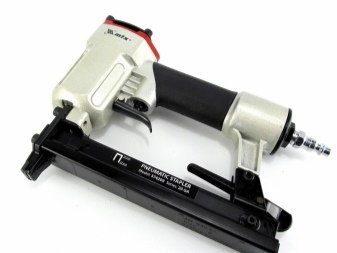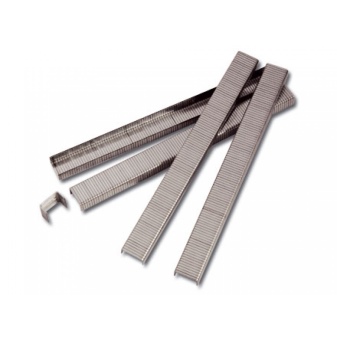Staples for pneumatic stapler

Pneumatic staplers can be used by specialists of different professions. They allow you to quickly and easily connect a variety of materials to each other. In this case, in addition to the device itself, you will also need consumables, primarily staples. Each individual type of such products has its own size and shape.


Types and sizes
Fasteners for pneumatic staplers can be produced in various forms.
-
U-shaped models. Such varieties are considered the most common option; they are universal rectangular fasteners for connecting materials.
-
T-shaped products. These patterns are quite rare. They allow you to make connections that will not carry the load.
-
U-shaped staples. Such devices are arcuate structures that can be used when working with cables.
Among the most modern varieties of such staplers, you can find universal devices, for the functioning of which several variants of staples are used simultaneously.



All of the above brackets may differ in their dimensions, which must also be taken into account before purchasing them.
-
Type 28. These models have a diameter of 4.5 mm. The height of their legs can range from 9 to 11 millimeters. The thickness is usually 1.25 mm.
-
Type 36. The staples have the same leg thickness and height as in the previous version, but their diameter is larger. They will be suitable for working with cables.
-
Type 53. Fasteners of this type have a thickness of only 0.7 mm, the height of the ends varies from 4 to 14 mm, the width is 11.3 mm.
-
Type 140. The products are 1.25 mm thick, 10.6 mm wide and 6-14 mm high at the ends.


Manufacturing materials
Fasteners for filling the pneumatic stapler can be made from a variety of processed metals. Let's analyze the most common types.
-
Steel. This material is most commonly used in the manufacture of these fasteners. It is characterized by high strength and durability. Steel bases will be able to withstand significant loads, while they will not deform even after a long time. But a significant drawback of these types of fasteners is considered their rapid defeat by corrosion, they begin to actively rust over time. The formation of a corrosive layer is most likely to occur if the joint structure is exposed to high humidity. All this will not only greatly spoil the external design of the connection, but also significantly reduce the level of its strength and reliability. Often such fasteners are made of special stainless steel, which will not lose its qualities even with high humidity. But it must be remembered that such products are quite fragile, so they can easily collapse under the influence of excessive loads. And also sometimes they use special galvanized steel. It is this material that has a fairly high resistance to the formation of a rusty layer on the surface, all this is achieved through a special top zinc coating. Such a basis for the manufacture of staples is also considered the most durable, has high strength and wear resistance, and the joints made with their help can last a fairly long time.

- Copper. This metal is also often used to create staples for construction pneumatic staplers.They have good resistance to the appearance of corrosion, but at the same time these products are suitable only in those cases when it is necessary to work with relatively soft materials. Such models of staples are perfect for wallpaper or under a layer of plaster, as they exclude the presence of smudges and other rusty marks. Often, it is these types of staples that are used as decorative elements when trimming furniture. But do not forget that copper options are quite expensive.

-
Aluminum. Aluminum braces are the cheapest option. But at the same time, they will not be suitable for working with too rigid materials. And also they should not be taken when connecting places that will be under significant pressure in the future.
Regardless of what kind of metal the staples are made of, they can be of 2 separate types: models with sharpened legs and with unsharpened ones. Working with the first option is much faster and easier, since they are better fixed, and also require a small impact force.

How to choose?
When choosing such fasteners for pneumatic staplers, it is worth considering a number of significant nuances. First of all, decide what materials you will have to work with. So, for the processing of harder structures, it is better to give preference to models created from steel raw materials. For processing softer products, copper options will also be perfect.
If you will use staples when decorating objects, including various furniture designs, then it is better to give preference to models painted in a suitable color.


Also, before purchasing staples, look at their sizes. So, for connecting cable structures, as a rule, larger versions are taken for a pneumatic stapler. For bonding thinner bases to each other, small models can also be purchased.
Pay attention to protective coatings. It is best to buy models with special coatings (galvanized steel).

Such products will not only provide reliable, but also the most durable fastening, because they will not rust and break over time. In addition, processed samples can be taken during the construction of various structures, which will then be located in the open air, since they are not afraid of atmospheric influences.















The comment was sent successfully.